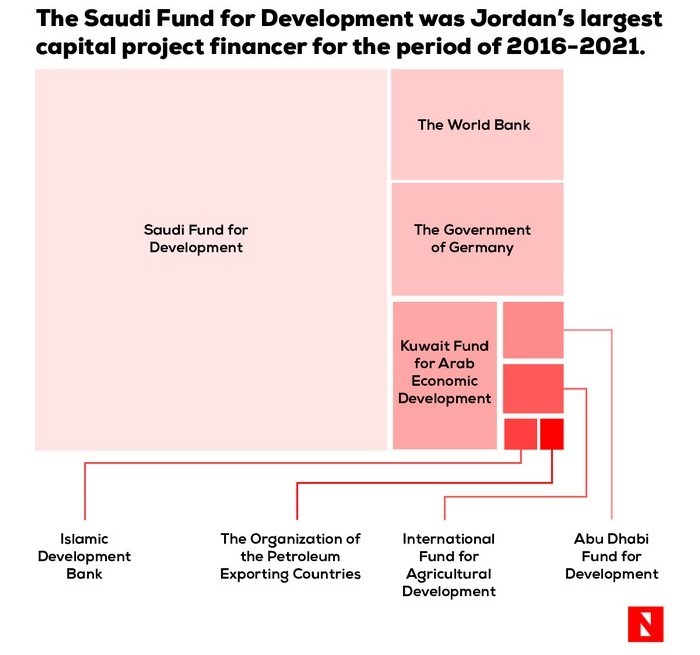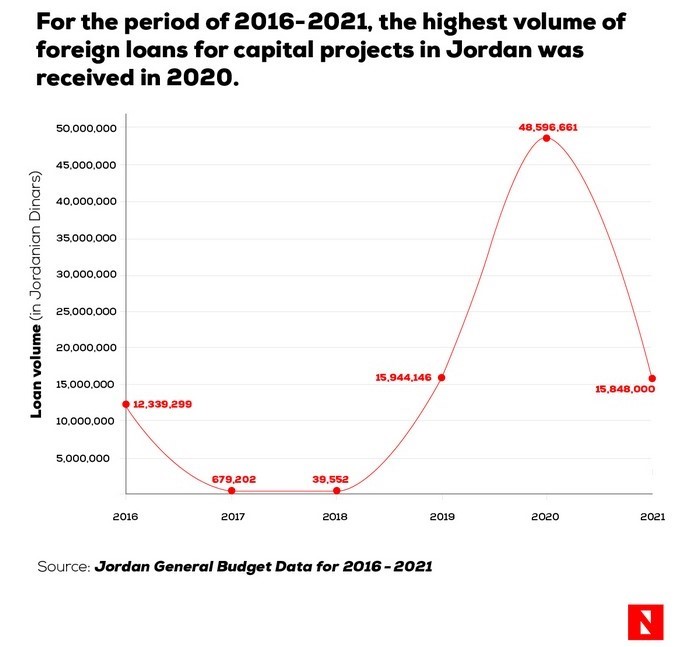AMMAN — Jordan
relies on foreign assistance to finance capital projects, as the country’s
domestic revenues are insufficient to fund new projects due to limited
available fiscal space. According to the 2021 State of the Nation Report issued
by the Economic and Social Council of Jordan, borrowing to cover current
expenditures is one shortcoming of Jordan's fiscal policy, as such loans rarely
go towards capital projects that add value to the productivity of the national
economy, an article run by Amman Net stated.
اضافة اعلان
However, when foreign financing is directed towards productive projects, where does that money come from, and what
projects does it support?
An analysis of general
budget data for the period 2016-2021 reveals significant year-to-year
differences in the volume of foreign loans financing capital projects, with
varying spending priorities.
The highest value of foreign loans financing capital projects was recorded in 2020, when Jordan’s government received approximately JD48.6 million, mainly… designated for completing the Desert Highway rehabilitation project.
According to the
budget data, the highest value of foreign loans financing capital projects was
recorded in 2020, when Jordan’s government received approximately JD48.6
million, mainly provided by the
Saudi Fund for Development (SFD) and designated
for completing the Desert Highway rehabilitation project. In 2018, on the other
hand, foreign loans received for capital projects totaled less than JD40,000.
Prominent lending
bodiesFor the six-year
period of 2016-2021, the SFD topped the list of loan providers financing
capital projects in Jordan, supplying the Kingdom with JD67.3 million, or 72
percent of total loans received during that period. The entirety of the SFD
financing went towards the Desert Highway rehabilitation project.
The Saudi fund’s loan
covered about 50 percent of the total cost of the project, while the rest was
financed from Jordan’s Treasury.

Overall, the rate of
contribution of foreign loans to the total financing for Jordan’s major
projects ranges between 67 and 100 percent, with the exception of only the
Desert Highway rehabilitation project (50 percent) and a project to establish
25
schools in 2017.
On Jordan’s roster of
capital project financers, the World Bank came in second for the six-year
period, contributing about JD9.3 million directed mainly towards a project titled
“Education Reform for Knowledge Economy”, which aims to support the Kingdom to
transform the education system at the early childhood, basic, and secondary
levels to instill graduates with the skills needed for the knowledge economy,
according to the World Bank.
For the year 2021, the
Kuwait Fund for Arab Economic Development was the most prominent capital
project financer in the Kingdom, providing loans worth JD7.5 million.
Roads, schools, and
hospitalsOn a sector level,
where does the funding go? As previously mentioned, infrastructure and public
works (such as roads and highways) are one major recipient of capital project
loans in the Kingdom.
Education is another
obvious choice for development projects worldwide, and Jordan is no exception. During
the six-year period from 2016-2021, the education sector received its highest
share of foreign loans for capital projects in 2016, with foreign contributions
to sector development declining between 2017 and 2020.

The health sector also
received significant external funding in 2016 as the Kingdom established the
new
Zarqa Government Hospital and expanded Al-Bashir hospital in Amman. After
that, health projects were absent from the list of capital projects financed by
external loans until the end of 2020, according to data from the general
budget.
Treasury bonds: an
alternative source of funding?Raad Al-Tal, an
economic expert, expressed the opinion that Jordan suffers from mismanagement
of foreign grants, aid, and loans. For example, he explained, the total volume
of grants and loans for the period from 2009-2019 reached JD26 billion,
however, the impact of this significant quantity of funding “was not directly
felt”, whether in the Kingdom’s infrastructure or its health and education
sectors.
The expert also noted
that the administration of grants, aid, and loans is subject to external constraints,
as lenders may determine the field of spending in a way that is inconsistent
with local priorities.
According to a report
issued by the
Jordanian Strategy Forum in 2017, economists consider that the
dependence of the Jordanian government on foreign aid, soft loans, and internal
and external borrowing to finance the country’s deficit and fund capital
projects highlights the need to find alternative sources of financing.
The total volume of grants and loans for the period from 2009–2019 reached JD26 billion, however, the impact of this significant quantity of funding “was not directly felt”.
Experts from the forum
noted that it is “surprising” that bonds issued by the central government and
governmental agencies are not traded in the secondary market.
Tal explained that treasury
bonds represent a type of government debt instrument that the government can
benefit from in operational spending by paying salaries or capital spending, which includes productive projects.
Offering these bonds
for trade in the secondary market can increase their demand, which is then reflected
in the government's ability to finance capital projects, he said. “The broader
the options and the more varied the borrowing mechanisms, the greater the
ability to collect amounts at lower, more competitive interest rates,” the expert
said.
Conversely, the
absence of a sound policy for issuing these bonds increases the government's
dependence on foreign loans, he said.
This article was
produced with support from “100 Watts” for investigative journalism in Jordan,
a joint project by Arab Reporters for Investigative Journalism and the Embassy
of the Kingdom of the Netherlands to Jordan.
Read more Business
Jordan News



